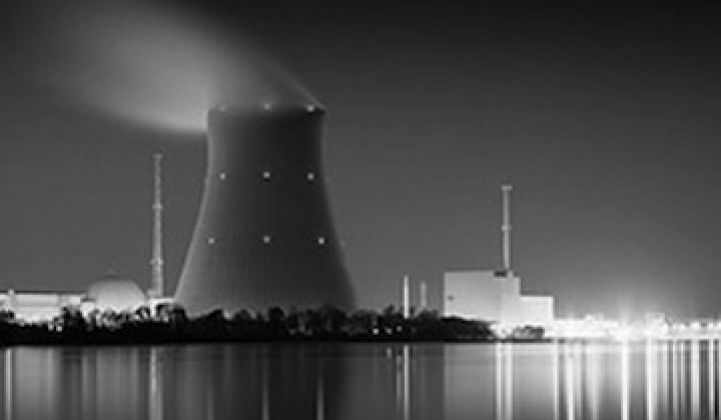The 9.0 earthquake in Japan and subsequent problems with its reactors have compelled anti-nuclear groups to rush to renew their attacks on nuclear power. All of Fukushima's reactors correctly triggered shut-downs of fission chain reactions when the earthquake hit. What caused problems was the inadequate removal of after-heat generated by radioactive fission products in over-heated fuel elements, when emergency pumps and piping were destroyed. These problems were overcome and all systems are now in "cold shutdown." That is, all Fukushima reactor cores are contained within thick quake-proof vessels.
Some radioactive gas leaked into the cooling water piped out of those vessels, and some overheated water/steam was released to the atmosphere due to pressure build-up. This has caused some radioactive dusting of nearby grass and spinach fields. However, radiation levels are low and most I-131 radioactivity will decay in weeks, while Cs-137 and Sr-90 can be removed by decontamination agents. There are no radiation-caused fatalities in the public due to the Fukushima accident and the released radioactivity is far below the level associated with Chernobyl fallout, which came from a burning, uncontained graphite-moderated reactor core.
The assertion by anti-nuclear clubs that thousands of Japanese can still die in coming years from delayed radiation-caused cancers (claimed also for people at Chernobyl) is without substantiation. In fact, there is some evidence that exposure to low-level nuclear radiation can actually benefit human health (due to a process called hormesis). While there were zero nuclear fatalities and measures have been taken globally to re-check all reactor core cooling systems and used-fuel pools for possible improvements, some anti-nuclear groups still want to shut down all existing nuclear plants and cancel all planned new-builds. This is as absurd as halting all air travel and aircraft manufacture because of 9/11.
Nuclear power will be essential for the rescue of our civilization when oil fields are depleted after 2050. A five-fold expansion of nuclear generation must be underway by 2030 to avoid a worldwide economic disaster when oil becomes scarce. Billions of kilowatts of "mother" electricity are needed to replace petro-fuel energy for the empowerment of vast fleets of electric plug-in autos; heavy industry; and production of portable green synfuels (hydrogen, ammonia, and biofuels). These items comprise 65 percent of all energy consumption, while urban and rural energy for heating, lighting, etc. consume the remaining 35 percent. Popular solar and wind power are useful for small-quantity needs in select locations and might provide up to 10 percent of all electricity. But to generate multi-terawatts of solar and wind energy requires immense areas of land or sea with enormous maintenance costs. It also spoils scenic land- or sea-scapes and destroys local ecosystems.
As documented in The Nuclear Imperative: A Critical Look at the Approaching Energy Crisis, when oil fields are depleted, only uranium and thorium can affordably sustain all global energy needs for more than 5,000 years using proven advanced reactor technology. Green nuclear power is the only practical solution to simultaneously overcome oil/gas depletion, ameliorate global warming, and help us avoid dependence on foreign oil and gas. Only coal and uranium can affordably deliver terawatts of electric power. However, coal worsens global warming and should be preserved as raw material to make plastics and other organics when oil and gas are gone. This leaves uranium as the only proven "big-mama" green energy source -- an "inconvenient truth" if there ever was one.
For the U.S., 500 additional gigawatt nuclear reactors are needed, built on 9,000 acres (~ $1.5 trillion), equivalent to 1,500,000 windmills, with storage batteries that will require 10,000,000 windy acres (~ $4.5 trillion). (All costs are in 2005 dollars.) Because it takes a decade to design, license, and build a reactor, action must be taken immediately to prevent an economic catastrophe by 2030 when oil starts to run out. Contrary to false propaganda by anti-nuclear groups, the cost of electricity at terawatt levels is three times less expensive with nuclear than for wind or solar. Solar and wind power requires expensive energy storage systems (batteries, etc.) when there is no sunshine or wind. Furthermore, many miles of access roads are needed to keep blades or solar panels clean from bird droppings, dead birds, and for repairs due to erosion, storm damage, earthquakes, and the periodic replacement of electrodes in storage batteries. Should the U.S. limit itself to solar and wind energy, it is guaranteed to become impoverished and dependent on portable synfuels imported from other countries (future OP(etrol)ECs -> OS(ynfuel)ECS) that expanded nuclear power generation in time before the oil fields were depleted.
***
Dr. Jeff W. Eerkens received an MS degree in nuclear engineering in 1957, and a PhD in engineering science in 1960 from the University of California at Berkeley. During completion of his PhD thesis, he worked full-time as a nuclear engineer at Aerojet-General-Nucleonics in nearby San Ramon. He was physicist-in-charge for the "critical" assembly of two AGN-211 reactor installations at Rice Institute and the University of Oklahoma. After graduating in 1960, Dr. Eerkens worked as an engineer-scientist for several high-tech companies in the Los Angeles area (Aerospace, Northrop, Garrett AiResearch) to develop space satellite power and laser systems. In 1977, he founded the LISCHEM corporation to manufacture high-power infrared lasers and laso-chemical reactors. Three years later he formed a partnership with industrialist Dick Griot (founder of Melles-Griot) to finance the R&D of his patented CRISLA process for laser enrichment of Uranium. Dr. Eerkens recently released the book The Nuclear Imperative (published by Springer) and is promoting combustion engines that burn ammonia to replace petro-fuels.



